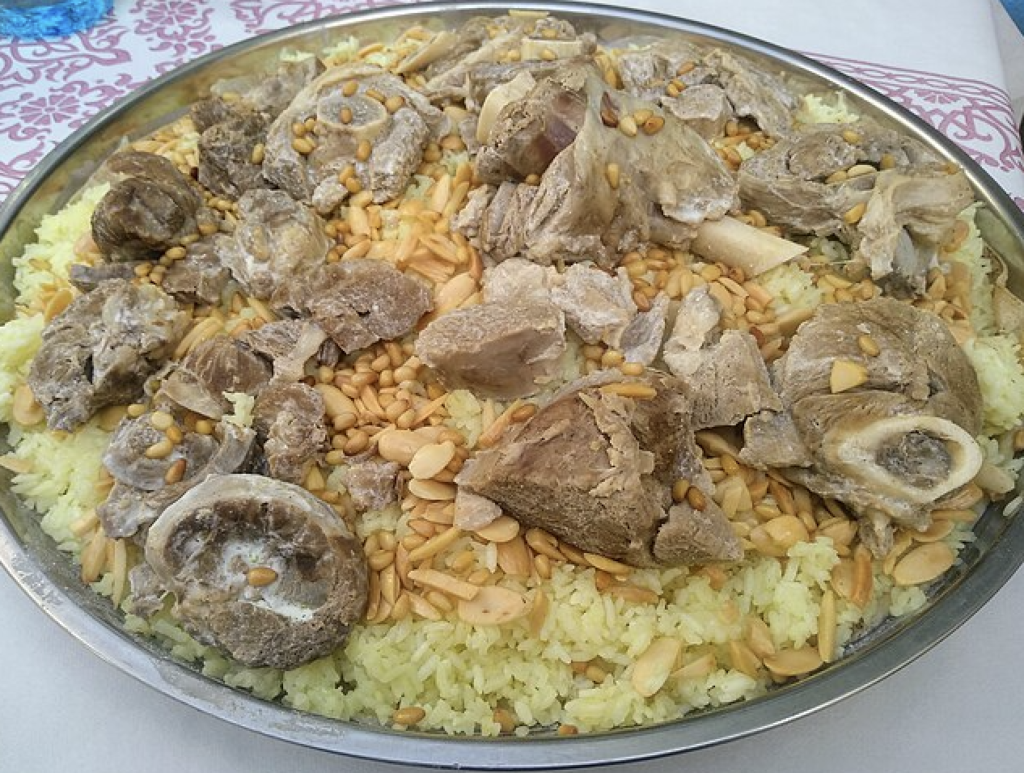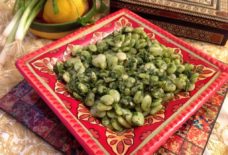The Three Faces of Mansaf: A Culinary Reflection of Jordanian and Palestinian Lifestyles

By: Yara Marei / Arab America Contributing Writer
In Jordanian and Palestinian culture, mansaf is more than just a dish; it is a symbol of heritage, hospitality, and communal values. This traditional meal, steeped in history and cultural significance, brings people together to share not just food but a sense of identity and belonging. Mansaf’s story is a fascinating blend of tradition, culinary artistry, and the rich tapestry of Jordanian and Palestinian life.
Mansaf, the beloved dish of Jordan and Palestine, is a powerful symbol of cultural heritage and communal values. However, Mansaf is not a monolithic dish; its preparation varies significantly across different regions, shaped by the historical lifestyles, climates, and agricultural practices of the cities in Jordan and Palestine. These variations, particularly in the type of yogurt used—whether fresh yogurt, jameed, or other regional adaptations—offer a unique glimpse into the diverse culinary traditions of the area.
Northern Cities: The Fresh Yogurt Mansaf
In northern Jordan and Palestine, such as Amman, Jenin, Nablus, and Salt, Mansaf is typically made with fresh goat yogurt. These regions’ cooler climate and fertile lands have historically supported extensive farming activities, including sheep and goat herding. This agricultural abundance ensured a consistent supply of fresh milk, which was then used to produce fresh yogurt.
The rural lifestyle of these northern cities meant that families were closely connected to the land, relying heavily on farming and livestock for sustenance. The availability of fresh yogurt made it the preferred ingredient for preparing Mansaf, resulting in a dish with a lighter, more delicate flavor that pairs perfectly with the tender lamb and seasoned rice. Fresh yogurt in Mansaf reflects the deep-rooted agricultural traditions of the northern regions, where the rhythms of farming life have long influenced the local cuisine.
Central and Southern Regions: The Jameed Mansaf
In contrast, cities such as Hebron (Al-Khalil), Jerusalem, and Karak, located in the central and southern parts of Jordan and Palestine, have historically relied on jameed, a preserved form of yogurt, for their version of Mansaf. This difference is rooted in the distinct climates and lifestyles of these regions.
The central and southern regions experience hotter, drier climates, historically making it difficult to maintain a consistent supply of fresh dairy products. Unlike the northern regions, where farming was a primary occupation, these areas were less agriculturally focused. Consequently, fresh yogurt was not always readily available. To address this challenge, the people in these regions developed the practice of preserving yogurt by drying it into hard balls known as jameed. This preserved yogurt could be stored for extended periods, making it an ideal ingredient for Mansaf in regions where fresh dairy was less accessible.
Jameed gives Mansaf a distinctive, rich flavor with a tangy depth that sets it apart from the version made with fresh yogurt. Reconstituting jameed into a sauce adds a layer of complexity to the dish, as the yogurt must be soaked and blended to achieve the desired consistency. This version of Mansaf is a testament to the resourcefulness of the people in Hebron, Jerusalem, and Karak, who adapted their cooking methods to suit their environment.
The Syrian Influence: Shakreyyeh Mansaf
In Syria, a variation of Mansaf known as Shakreyyeh offers another twist on this beloved dish. Although not traditionally considered Mansaf in Jordan and Palestine, Shakreyyeh shares some similarities, particularly in its use of yogurt. However, Shakreyyeh is typically made with a thickened yogurt sauce with a lot of starch and a less tangy, sour, and salty taste than the Jordanian or Palestinian, and often features chicken or beef instead of lamb.
In Syria, Shakreyyeh is not associated with the same cultural and communal significance as Mansaf in Jordan and Palestine, but it remains a popular dish in its own right, reflecting the broader Levantine tradition of yogurt-based stews. The yogurt in Shakreyyeh is usually fresh, similar to that found in the northern Jordanian and Palestinian cities. Still, the preparation and presentation differ, resulting in a lighter, more soupy dish that is served over rice or bulgur.
The Preparation Process
The preparation of Mansaf is both an art and a ritual. It begins with preparing jameed, made from fermented and dried goat’s milk yogurt. The jameed is soaked in water and blended into a thick, creamy sauce. This sauce is the heart of Mansaf, giving it a distinct, tangy flavor that is unlike any other dish.
The lamb is traditionally cooked in the jameed sauce until tender and flavorful. The rice, often seasoned with turmeric, cinnamon, and cardamom, is cooked separately. Traditionally, a thin layer of flatbread, known as “shrak” or “markook,” is placed at the bottom of the serving platter. The rice is then spread over the bread, and the lamb pieces are arranged on top. Finally, the jameed sauce is poured generously over the entire dish and garnished with toasted nuts and fresh herbs.
Cultural Significance
Mansaf is more than just a meal; it is a cultural emblem. In Jordan and Palestine, it is customary to eat Mansaf communally, with everyone gathering around a large platter. Traditionally, it is eaten with the right hand, with participants using bread to scoop up the rice and lamb. This method of eating fosters a sense of community and equality, as everyone shares the same dish.
Mansaf also plays a crucial role in social and political contexts. It is often served to honor guests, resolve disputes, and celebrate major life events. In many villages, offering Mansaf is a gesture of goodwill and respect. During large gatherings, the preparation and serving of Mansaf can become a collaborative effort, reinforcing communal bonds.
The Secrets Behind the Dish
The secrets behind a perfect Mansaf lie in the quality of its ingredients and the skill of its preparation. The jameed must be of high quality, as it is the foundation of the dish’s flavor. Authentic jameed can be difficult to find outside of Jordan and Palestine, but it is increasingly available in Middle Eastern markets around the world.
The lamb should be fresh and preferably from a young animal, as this ensures tenderness and a milder flavor. Slowly cooking the lamb in the jameed sauce allows the meat to absorb the yogurt’s unique tanginess, creating a harmonious blend of flavors.
The rice must be fluffy and well-seasoned. While some modern versions of Mansaf incorporate a variety of spices, traditional recipes rely on a simple seasoning of turmeric to give the rice its characteristic golden color.
Finally, the bread used in Mansaf is not just a base but an integral part of the dish. Shrak or markook bread, thin and slightly crispy, absorbs the jameed sauce, adding another layer of texture and flavor.
In the northern cities of Jordan and Palestine, where fresh yogurt is abundant, Mansaf celebrates agricultural life and the close relationship between people and their land. In Hebron, Jerusalem, and Karak, the use of jameed highlights the importance of preservation and adaptability in a region with a harsher climate. Meanwhile, Shakreyyeh represents a regional twist that, while distinct, still connects to the broader tradition of yogurt-based dishes in the Levant.
These variations of Mansaf highlight the rich tapestry of Jordanian and Palestinian culinary heritage, where a single dish can take on many forms, each with its unique flavor and cultural significance.
Modern Adaptations and Global Influence
As Jordanians and Palestinians have migrated around the world, they have taken Mansaf with them, introducing this beloved dish to new audiences. Mansaf has become a staple in restaurants and family gatherings in many cities with large Middle Eastern communities. While traditional recipes are cherished, modern adaptations have emerged, including vegetarian versions and variations using different types of meat.
Despite these changes, the essence of Mansaf remains the same: it is a dish that brings people together, celebrates heritage, and embodies the spirit of generosity and hospitality.
Give it a Try!
Mansaf is more than just a dish; it reflects the diverse lifestyles, climates, and historical contexts of the regions where it is prepared. Whether it’s the fresh yogurt Mansaf of the northern cities, the jameed-based Mansaf of the central and southern areas, or the Shakreyyeh of Syria, each variation tells a story of adaptation, resourcefulness, and cultural identity.
See our blog here!









